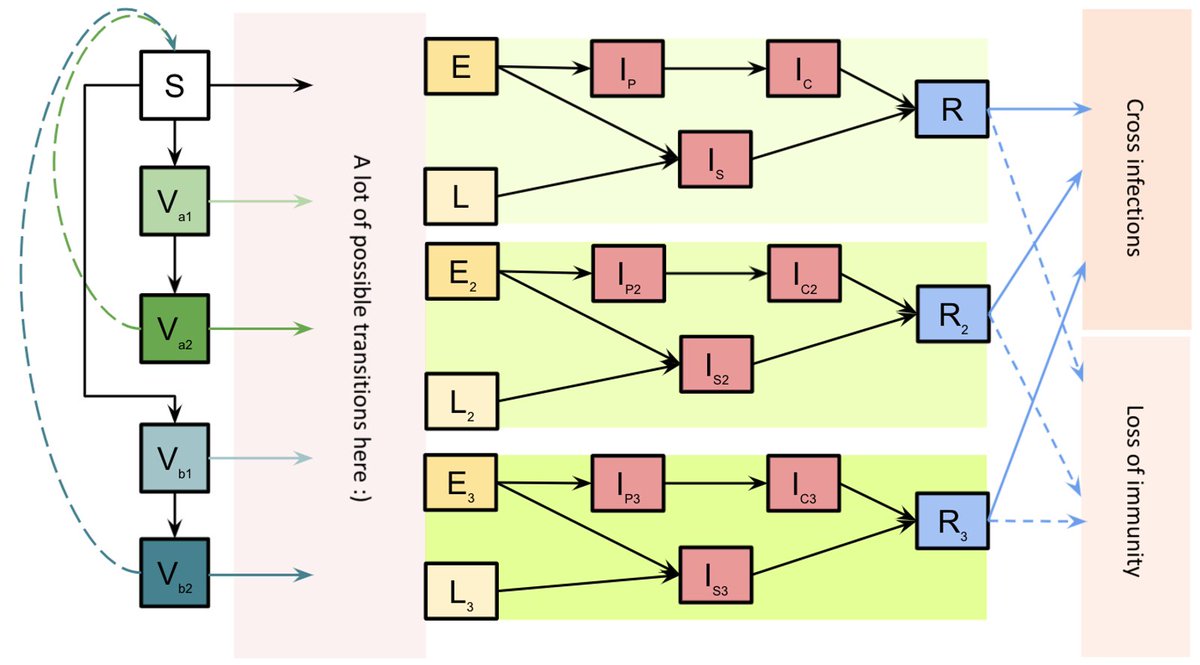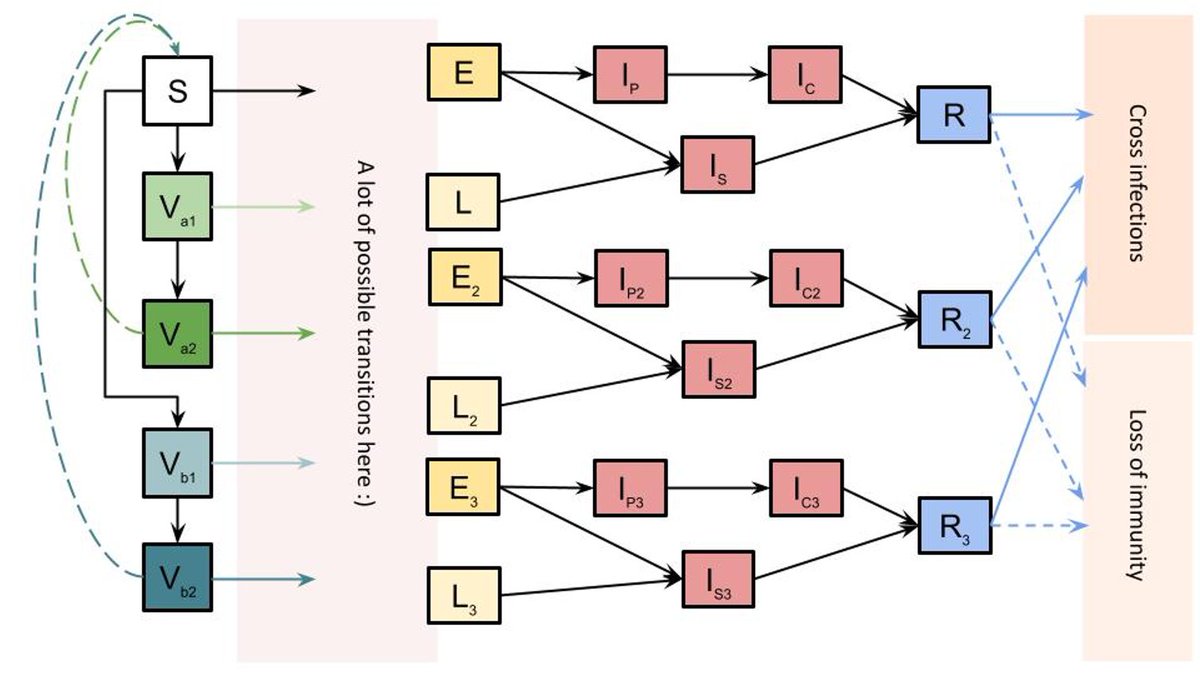
My research (with @_nickdavies @cmmid_lshtm @markjit & John Edmunds) is published in @NatureComms 🥳
This is the culmination of many months of work (my funding from @Epipose)🍾🎉
nature.com/articles/s4146…
Until I write a book on this (publishers/agents hmu😝), here is a 🦣🧵
This is the culmination of many months of work (my funding from @Epipose)🍾🎉
nature.com/articles/s4146…
Until I write a book on this (publishers/agents hmu😝), here is a 🦣🧵
The code to reproduce this work is available at: github.com/rosannaclaireb… 🛠️⚙️🧩🏗️
This implementation of 'covidm' builds on work by @_nickdavies (the OG creator) in the early #COVID days
Since joining @LSHTM in July 2020, I have developed covidm with @_nickdavies
👩💻👩🔧👩🎨👩💼👩🔬
This implementation of 'covidm' builds on work by @_nickdavies (the OG creator) in the early #COVID days
Since joining @LSHTM in July 2020, I have developed covidm with @_nickdavies
👩💻👩🔧👩🎨👩💼👩🔬
Early 2020 discussions @cmmid_lshtm led @_nickdavies to build #covidm
CMMID members @LSHTM (e.g. @rozeggo, John Edmunds, & @adamjkucharski) contributed to these discussions
Many other colleagues contributed to model development (e.g. @cap1024 @Lloyd_Chapman_ @KevinvZandvoort)
CMMID members @LSHTM (e.g. @rozeggo, John Edmunds, & @adamjkucharski) contributed to these discussions
Many other colleagues contributed to model development (e.g. @cap1024 @Lloyd_Chapman_ @KevinvZandvoort)
The first work I was involved in with #covidm explored the effect of regional tiered #restrictions and the second #lockdown in England (work with @_nickdavies @jarvisc @timwrussell @ProfCalumSemple @markjit & John Edmunds, ofc!)
sciencedirect.com/science/articl…
@cmmid_lshtm @CCPUKstudy
sciencedirect.com/science/articl…
@cmmid_lshtm @CCPUKstudy
I wrote a Twitter thread 🧵 on that paper here:
https://twitter.com/BarnardResearch/status/1342087036241666049
Not long after, I was involved in work led by @_nickdavies using #covidm (and other methods) to explore the impact of the Alpha B.1.1.7 variant of concern (#VOC) on #SARSCoV2 transmission in England 🦠❤️🩹🏴
This is now published in @ScienceMagazine ⤵️
science.org/doi/10.1126/sc…
This is now published in @ScienceMagazine ⤵️
science.org/doi/10.1126/sc…
At this point #covidm was implemented as a two-strain or two-variant model with vaccination (see attached image)
This allowed us to model the Alpha VOC taking over from previous #SARSCoV2 variants in England, as well as the mitigating effect of #COVID19 #vaccines on transmission
This allowed us to model the Alpha VOC taking over from previous #SARSCoV2 variants in England, as well as the mitigating effect of #COVID19 #vaccines on transmission

In January 2021, I built extra compartments into #covidm so that we could explore the effect of vaccination in England in more detail, such as the timing and number of vaccine doses received.
The model now included:
2⃣ vaccine products (viral-vector; mRNA) &
2⃣ vaccine doses 💉
The model now included:
2⃣ vaccine products (viral-vector; mRNA) &
2⃣ vaccine doses 💉

Next, we (me @_nickdavies @markjit & John Edmunds) used #covidm to produce scenarios assessing the potential impact of relaxing restrictions (the so-called #roadmap out of lockdown in England) 🔒👎
These scenarios provided evidence to decision makers ⤵️
gov.uk/government/pub…
These scenarios provided evidence to decision makers ⤵️
gov.uk/government/pub…
After the (somewhat traumatic) experience of rushing to model the Alpha B.1.1.7 VOC, and living through the resulting lockdown, in March 2021 I decided to add some latency into #covidm…
This took the form of a third SARS-CoV-2 variant (use in case of emergencies!🦺)
2⃣➡️3⃣
This took the form of a third SARS-CoV-2 variant (use in case of emergencies!🦺)
2⃣➡️3⃣

Over the next few months, we (cc @_nickdavies @markjit & John Edmunds) produced lots more roadmap modelling scenarios, coinciding with each staged relaxation 👐☺️
In May 2021, the third modelled variant was already in use for hypothetical VOC scenarios:
gov.uk/government/pub…
In May 2021, the third modelled variant was already in use for hypothetical VOC scenarios:
gov.uk/government/pub…
Roadmap step 3⃣ went ahead as planned
By June 2021, the Delta B.1.617.2 VOC was spreading in England ... 🦠
We fitted our model to genomic sequencing data for Delta, explored scenarios for characteristics of Delta & considered step 4⃣ of the roadmap ⤵️
gov.uk/government/pub…
By June 2021, the Delta B.1.617.2 VOC was spreading in England ... 🦠
We fitted our model to genomic sequencing data for Delta, explored scenarios for characteristics of Delta & considered step 4⃣ of the roadmap ⤵️
gov.uk/government/pub…
Roadmap step 4⃣ was delayed from its original planned implementation date.
That meant we needed another round of modelling looking at the impact of Delta B.1.617.2 and delayed step 4⃣
I wrote another Twitter thread 🧵 then (which links to the report ⤵️)
That meant we needed another round of modelling looking at the impact of Delta B.1.617.2 and delayed step 4⃣
I wrote another Twitter thread 🧵 then (which links to the report ⤵️)
https://twitter.com/BarnardResearch/status/1414636107548045317
Whilst posting our research *output*, I want to note how hard it was in reality...
We (shoutout @_nickdavies @markjit John Edmunds) were often working late and under a lot of pressure 😑🗜️🤯‼️
[video recorded at 01:19 on 7th July 2021; I finished the report around 4am😪]
We (shoutout @_nickdavies @markjit John Edmunds) were often working late and under a lot of pressure 😑🗜️🤯‼️
[video recorded at 01:19 on 7th July 2021; I finished the report around 4am😪]
In the Autumn of 2021, we spent more time on #covidm development:
▶️ adding Va2w & Vb2w compartments (allowing more accurate modelling of boosters & waning)
▶️ updating @ONS population estimates
▶️ new method for historic time-varying transmission adjustments to better fit data
▶️ adding Va2w & Vb2w compartments (allowing more accurate modelling of boosters & waning)
▶️ updating @ONS population estimates
▶️ new method for historic time-varying transmission adjustments to better fit data

Then we provided more evidence to UK decision makers: autumn/winter 2021-22 scenarios & contingency ("Plan B") measures...
📌booster vaccines, waning vaccine protection
📌vaccination of 12-15 year old children
📌& assuming the delta VOC remains dominant
gov.uk/government/pub…
📌booster vaccines, waning vaccine protection
📌vaccination of 12-15 year old children
📌& assuming the delta VOC remains dominant
gov.uk/government/pub…
Finally, it was time for me to focus on the metrics that #academia cares about: first-author peer-reviewed publications 🥁📜🏆🏅🍾👑💥
I started to wrap up the aforementioned work into a paper exploring key factors influencing dynamics of #SARSCoV2 transmission in England, projected forwards to September 2022 🔐
The key factors turned out to be
🍏behaviour change,
🍏booster vaccinations, and
🍏waning immunity
The key factors turned out to be
🍏behaviour change,
🍏booster vaccinations, and
🍏waning immunity

I sent the paper off to peer-review and submitted the preprint to @medrxivpreprint on 29th November 2021
👏🤞👇🤘
medrxiv.org/content/10.110…
👏🤞👇🤘
medrxiv.org/content/10.110…
Six days later, we (me @_nickdavies @cap1024 @markjit & John Edmunds) had to start looking at #Omicron scenarios 🤯
(we firstly called these 'Nu' scenarios, as we started them before the @WHO named Omicron!)
My Twitter thread links to that report here:
(we firstly called these 'Nu' scenarios, as we started them before the @WHO named Omicron!)
My Twitter thread links to that report here:
https://twitter.com/BarnardResearch/status/1469646833563615237
Switching back to my paper under peer-review in late 2021 🔙
Our peer-review reports were returned later in December ...
TLDR: the reviewers liked the work, but the Omicron variant was appearing likely to have a significant impact on the relevance of our modelling results
🤐🫠
Our peer-review reports were returned later in December ...
TLDR: the reviewers liked the work, but the Omicron variant was appearing likely to have a significant impact on the relevance of our modelling results
🤐🫠
In 2022 me, @_nickdavies, @markjit, & John Edmunds decided to overhaul the paper, exploring the same questions
i.e. what are the factors influencing projected #SARSCoV2 transmission dynamics in England
& considering the huge wave of Omicron transmission that begun in late 2021
i.e. what are the factors influencing projected #SARSCoV2 transmission dynamics in England
& considering the huge wave of Omicron transmission that begun in late 2021
By 24th March I had everything reproduced (data built, model fitting routines run, model projections generated, Figures produced, paper rewritten, response to peer-reviewers written) 😅
But..... Omicron BA.2 😰
bbc.co.uk/news/health-60…
This threw another spanner in the works 🔧
But..... Omicron BA.2 😰
bbc.co.uk/news/health-60…
This threw another spanner in the works 🔧
(Wow, just realised there is a 25-tweet drafting limit 🤯)
This rise in infections driven by #Omicron BA.2 contradicted our results in March, which assumed that #Omicron BA.1 would remain dominant, & projected a reduction in #COVID19 transmission in England until September 2022
This rise in infections driven by #Omicron BA.2 contradicted our results in March, which assumed that #Omicron BA.1 would remain dominant, & projected a reduction in #COVID19 transmission in England until September 2022
John Edmunds thought the work was becoming "increasingly anachronistic" (a beautiful turn of phrase which I couldn't forget 😂)
So we buckled up and worked to:
🧰incorporate @sangerinstitute data to inform BA2 taking over from BA1
🧰extend modelling projections to December 2022
So we buckled up and worked to:
🧰incorporate @sangerinstitute data to inform BA2 taking over from BA1
🧰extend modelling projections to December 2022
By May, the paper was finally ready 🍾🪩🥳🥲
We resubmitted the paper to be peer-reviewed and uploaded the pre-print to @medrxivpreprint
(the pre-print version is here medrxiv.org/content/10.110…)
We resubmitted the paper to be peer-reviewed and uploaded the pre-print to @medrxivpreprint
(the pre-print version is here medrxiv.org/content/10.110…)
After revising our paper in June to adhere to editorial requirements, we received news that @NatureComms had formally accepted the paper on 25th July 🎉🆒
I've linked the paper in tweet number 1 of this 🦣🧵
Thanks to @_nickdavies @cmmid_lshtm @markjit John Edmunds & @EpiPose
I've linked the paper in tweet number 1 of this 🦣🧵
Thanks to @_nickdavies @cmmid_lshtm @markjit John Edmunds & @EpiPose

• • •
Missing some Tweet in this thread? You can try to
force a refresh

















